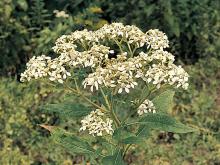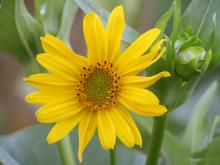Wildflowers, Grasses and Other Nonwoody Plants
Media

Species Types
Scientific Name
Oxalis stricta
Description
Yellow wood sorrel is both a garden weed and a wild edible. It has a pleasant sour taste, which is why some people call it sourgrass and add it to salads.
Media

Species Types
Scientific Name
Typha spp.
Description
Missouri’s cattails are all tall wetland plants with narrow, upright leaves emerging from a thick base, and a central stalk bearing a brown, sausage-shaped flower spike.
Media

Species Types
Scientific Name
Nymphaea spp.
Description
Water lilies are among the most beautiful of all water plants. They have large, round leaves 8–16 inches across, each with a single V-shaped notch.
Media

Species Types
Scientific Name
Nelumbo lutea
Description
American lotus is an aquatic plant with circular leaves that are held above water. The large yellow flowers have an interesting showerhead-like disk at the center.
Media

Species Types
Scientific Name
Sagittaria spp.
Description
Arrowheads are aquatic plants with erect, usually arrow-shaped leaves and distinctive three-petaled flowers. They are often called duck potatoes because ducks, geese, and swans relish the tuberlike rootstocks.
Media

Species Types
Scientific Name
Phytolacca americana
Description
A tall, smooth, branching plant with red stems and juicy, dark purple berries, pokeweed is both toxic and a traditional edible potherb called poke salat. It is common statewide.
Media

Species Types
Scientific Name
Lilium michiganense
Description
This native lily looks a lot like the Asian “tiger lily” that is commonly cultivated in gardens. Michigan lily, however, has leaves mostly in whorls and lacks the round “bulblets” that tiger lily forms in its leaf axils.
Media

Species Types
Scientific Name
Commelina communis
Description
The flowers of dayflower are truly blue, and they have only two conspicuous petals. A fast-growing, sprawling, but shallow-rooted weed, this introduced species commonly annoys gardeners.
Media

Species Types
Scientific Name
Verbesina virginica
Description
White crownbeard is a tall native perennial wildflower with clusters of white flowerheads. It's called “wingstem” for the narrow green wings running along the stem. It’s called “frostweed” because it forms "frost flowers": strange and beautiful formations at the stem bases after a sudden hard frost.
Media

Species Types
Scientific Name
Silphium perfoliatum
Description
Called carpenter’s weed for its remarkably square stems, cup plant is also notable for its large, opposite leaves that fuse around the stem to form a leafy cup that holds rainwater.
See Also
About Wildflowers, Grasses and Other Nonwoody Plants in Missouri
A very simple way of thinking about the green world is to divide the vascular plants into two groups: woody and nonwoody (or herbaceous). But this is an artificial division; many plant families include some species that are woody and some that are not. The diversity of nonwoody vascular plants is staggering! Think of all the ferns, grasses, sedges, lilies, peas, sunflowers, nightshades, milkweeds, mustards, mints, and mallows — weeds and wildflowers — and many more!





















